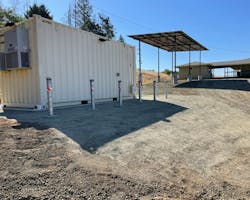PG&E Commissions 100% Renewable Remote Microgrid in Sonoma County
On Monday, Pacific Gas and Electric (PG&E) commissioned its first fully renewable remote grid in California. Located in Sonoma County’s Pepperwood Preserve, the installation will reduce wildfire risk in an area that was impacted by both the 2017 Tubbs Fire and the 2019 Kincaid Fire.
Remote grids, which are also known as remote microgrids, provide stand-alone local energy resources to defined areas, in this case Pepperwood Preserve’s Bechtel House, an overnight guesthouse used by visiting scientists, teachers and students.
“The close collaboration between PG&E and our project partners on the remote grid at Pepperwood is a prime example of how we can innovate to serve local needs as we carry out critical wildfire mitigation work,” said Joe Bentley, senior vice president of electric engineering at PG&E.
The Pepperwood remote grid replaces a nearly mile-long overhead distribution power line and, according to a statement from PG&E, eliminates the associated wildfire risk.
Fully powered by locally generated clean energy
The Pepperwood Preserve remote grid “creates a new model for cutting ratepayer costs and fire risks while achieving California’s renewable policy goals,” said Geof Syphers, CEO of Sonoma Clean Power, the local power generation provider for Sonoma and Mendocino counties.
The 3,200-acre Pepperwood Preserve, which is in the Mayacamas Mountains, is a living laboratory for climate monitoring, research and education, and it is home to more than 900 plant and wildlife species. The preserve also hosts wildfire resilience demonstration projects, including the ALERTWildfire camera network that helps first responders identify and manage their response to wildfires.
The remote grid includes a 17.36-kW direct current (DC) Standard Test Conditions canopy solar array, a 60.8-kWh DC battery energy storage system and a 27.2 kVa inverter. The project, which was completed in partnership with Pepperwood Preserve and Sonoma Clean Power, is completely off grid and free of fossil-fuel backup generation.
“As a research and education institution dedicated to showcasing best practices, we look forward to benefiting from this clean energy source and presenting it to visitors from near and far as part of a new wave of remote energy solutions,” said Lisa Micheli, president and CEO of the Pepperwood Foundation.
PG&E’s first fully renewable remote grid
Across its 70,000-square-mile service area, PG&E is investing in wildfire mitigation and system hardening by undergrounding, installing stronger and more resilient poles and building microgrids.
This is the fifth stand-alone remote grid PG&E has brought online since 2021 and the utility’s first fully renewable remote installation.
It was built in less than eight weeks by BoxPower, which provided both the solar array and the battery energy storage system. BoxPower will also handle ongoing maintenance of the installation.
Energy efficiency steps also taken to reduce electricity demand
Franklin Energy, a provider of turnkey energy efficiency and energy management programs, made a number of energy efficiency upgrades to the guesthouse including the installation of new energy efficient insulation and improvements to the HVAC and other systems.
These efforts ultimately reduced the guesthouse’s energy demand and will minimize potential outages when solar generation is low.
“Efficiency and renewable power go hand in hand,” said Brett Bishop, technical adviser for Franklin Energy. “It was rewarding for our team to put this synergy into practice while showing it can improve the lived experience at the house as well.”
Track news about utility microgrids. Subscribe to the free Microgrid Knowledge newsletter.










